Cost Estimation in Building Construction based on Australian Standards
VerifiedAdded on 2023/06/05
|12
|2675
|82
AI Summary
This project discusses the cost estimation in building construction based on Australian standards for a specific building. It covers the materials, labour, and plant required for the project, as well as the considerations that affect the decision to tender on a project. It also discusses the benefits of estimating costs by separately costing the plant, materials, and labour required. The article concludes by discussing the issues with obtaining quotations from strange specialist trades or companies and the on-costs associated with directly employed labour.
Contribute Materials
Your contribution can guide someone’s learning journey. Share your
documents today.
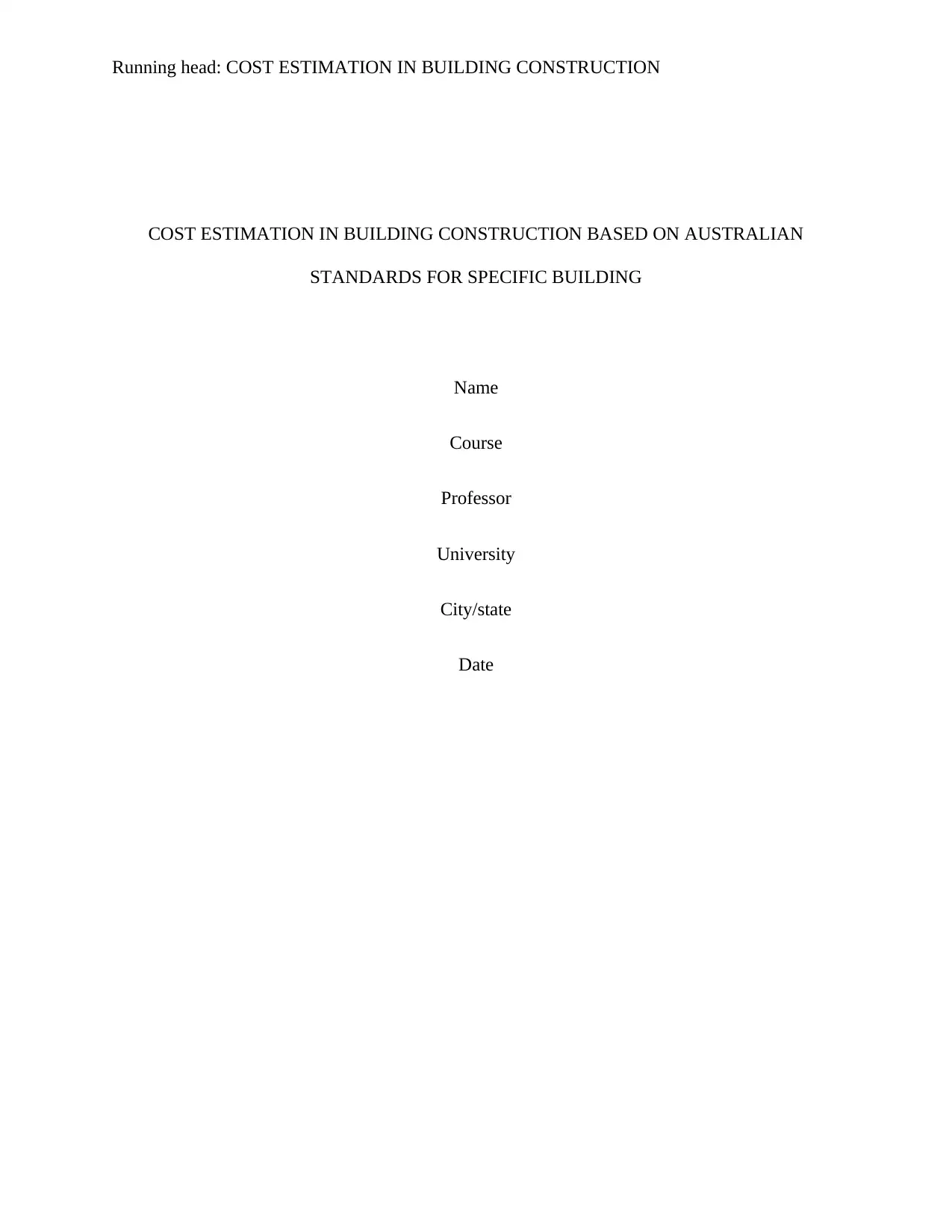
Running head: COST ESTIMATION IN BUILDING CONSTRUCTION
COST ESTIMATION IN BUILDING CONSTRUCTION BASED ON AUSTRALIAN
STANDARDS FOR SPECIFIC BUILDING
Name
Course
Professor
University
City/state
Date
COST ESTIMATION IN BUILDING CONSTRUCTION BASED ON AUSTRALIAN
STANDARDS FOR SPECIFIC BUILDING
Name
Course
Professor
University
City/state
Date
Secure Best Marks with AI Grader
Need help grading? Try our AI Grader for instant feedback on your assignments.
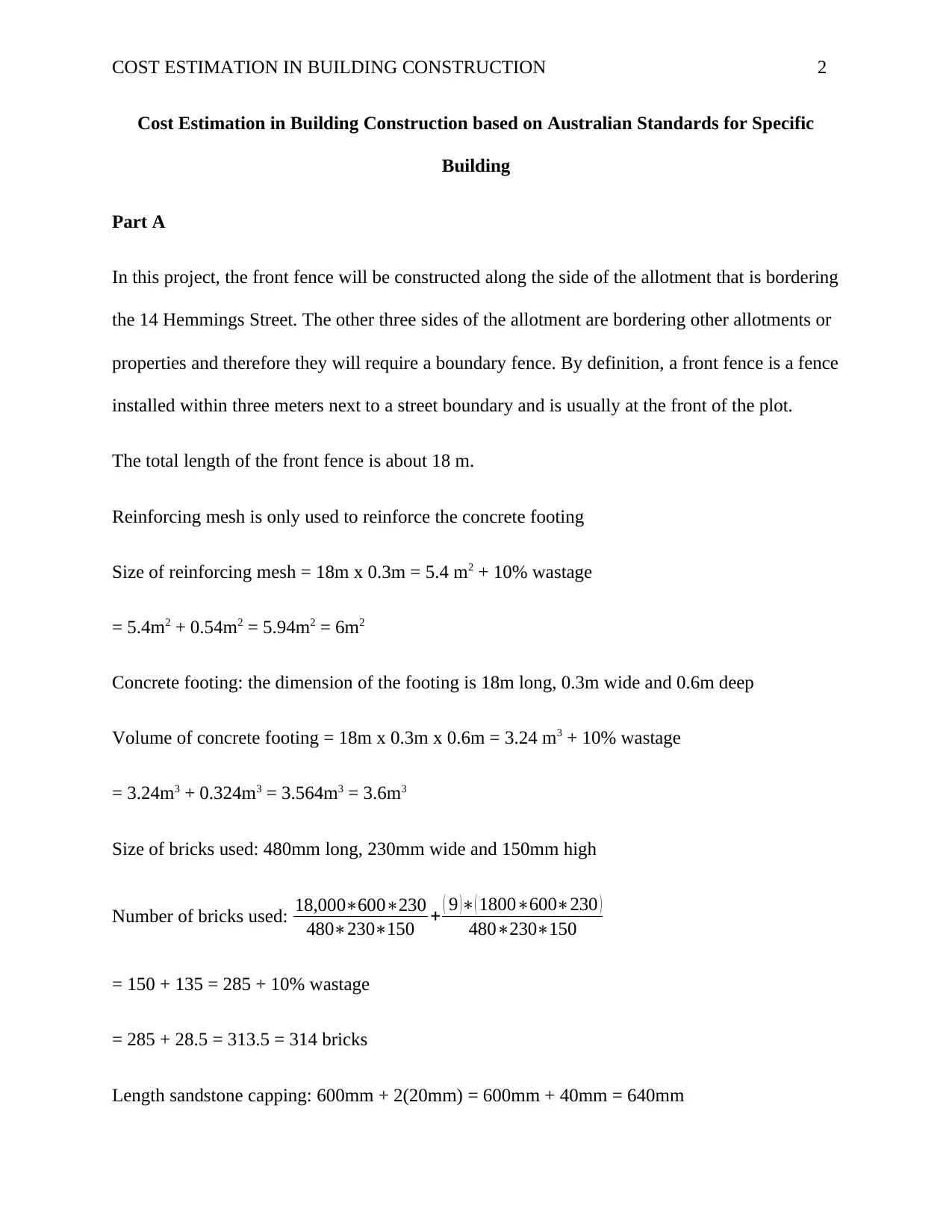
COST ESTIMATION IN BUILDING CONSTRUCTION 2
Cost Estimation in Building Construction based on Australian Standards for Specific
Building
Part A
In this project, the front fence will be constructed along the side of the allotment that is bordering
the 14 Hemmings Street. The other three sides of the allotment are bordering other allotments or
properties and therefore they will require a boundary fence. By definition, a front fence is a fence
installed within three meters next to a street boundary and is usually at the front of the plot.
The total length of the front fence is about 18 m.
Reinforcing mesh is only used to reinforce the concrete footing
Size of reinforcing mesh = 18m x 0.3m = 5.4 m2 + 10% wastage
= 5.4m2 + 0.54m2 = 5.94m2 = 6m2
Concrete footing: the dimension of the footing is 18m long, 0.3m wide and 0.6m deep
Volume of concrete footing = 18m x 0.3m x 0.6m = 3.24 m3 + 10% wastage
= 3.24m3 + 0.324m3 = 3.564m3 = 3.6m3
Size of bricks used: 480mm long, 230mm wide and 150mm high
Number of bricks used: 18,000∗600∗230
480∗230∗150 + ( 9 )∗( 1800∗600∗230 )
480∗230∗150
= 150 + 135 = 285 + 10% wastage
= 285 + 28.5 = 313.5 = 314 bricks
Length sandstone capping: 600mm + 2(20mm) = 600mm + 40mm = 640mm
Cost Estimation in Building Construction based on Australian Standards for Specific
Building
Part A
In this project, the front fence will be constructed along the side of the allotment that is bordering
the 14 Hemmings Street. The other three sides of the allotment are bordering other allotments or
properties and therefore they will require a boundary fence. By definition, a front fence is a fence
installed within three meters next to a street boundary and is usually at the front of the plot.
The total length of the front fence is about 18 m.
Reinforcing mesh is only used to reinforce the concrete footing
Size of reinforcing mesh = 18m x 0.3m = 5.4 m2 + 10% wastage
= 5.4m2 + 0.54m2 = 5.94m2 = 6m2
Concrete footing: the dimension of the footing is 18m long, 0.3m wide and 0.6m deep
Volume of concrete footing = 18m x 0.3m x 0.6m = 3.24 m3 + 10% wastage
= 3.24m3 + 0.324m3 = 3.564m3 = 3.6m3
Size of bricks used: 480mm long, 230mm wide and 150mm high
Number of bricks used: 18,000∗600∗230
480∗230∗150 + ( 9 )∗( 1800∗600∗230 )
480∗230∗150
= 150 + 135 = 285 + 10% wastage
= 285 + 28.5 = 313.5 = 314 bricks
Length sandstone capping: 600mm + 2(20mm) = 600mm + 40mm = 640mm
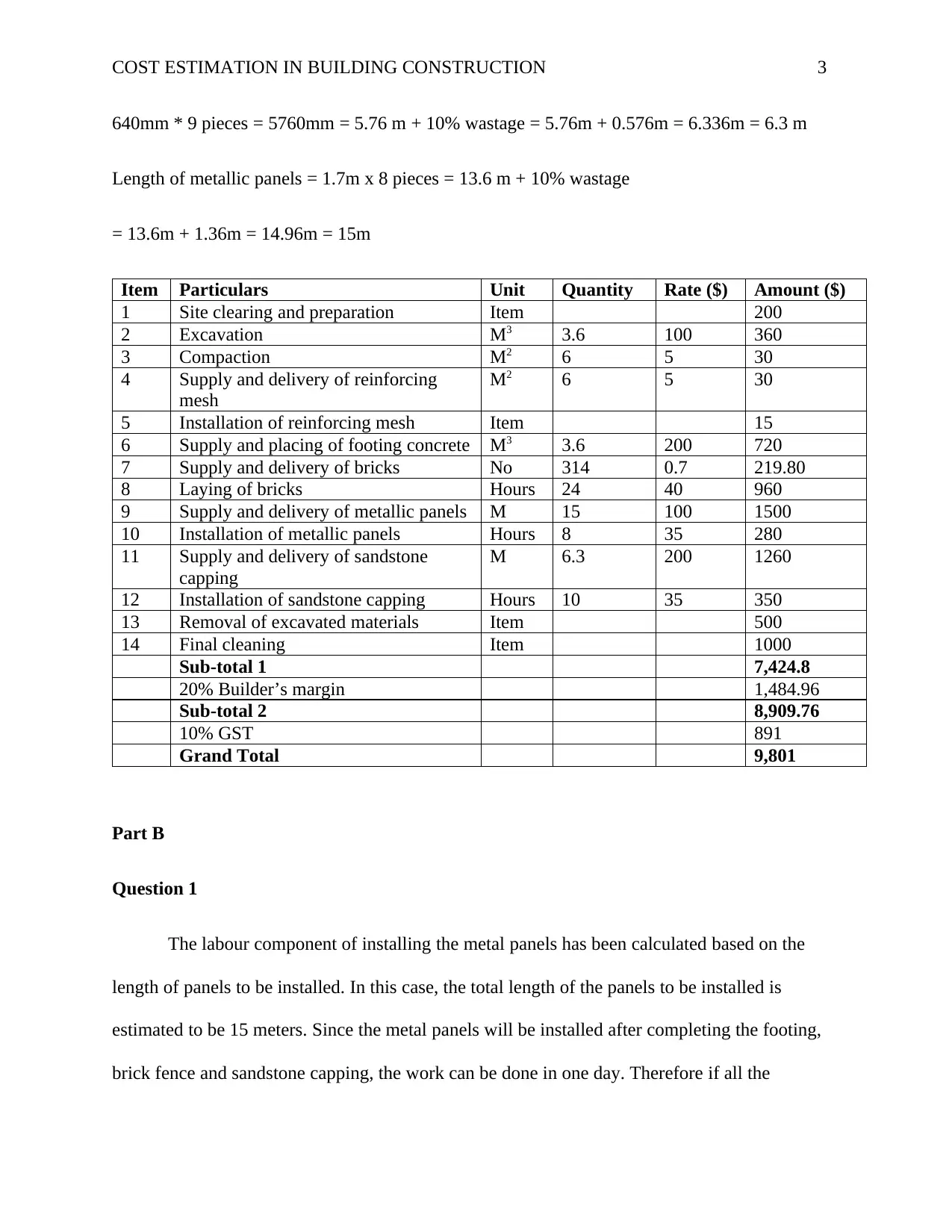
COST ESTIMATION IN BUILDING CONSTRUCTION 3
640mm * 9 pieces = 5760mm = 5.76 m + 10% wastage = 5.76m + 0.576m = 6.336m = 6.3 m
Length of metallic panels = 1.7m x 8 pieces = 13.6 m + 10% wastage
= 13.6m + 1.36m = 14.96m = 15m
Item Particulars Unit Quantity Rate ($) Amount ($)
1 Site clearing and preparation Item 200
2 Excavation M3 3.6 100 360
3 Compaction M2 6 5 30
4 Supply and delivery of reinforcing
mesh
M2 6 5 30
5 Installation of reinforcing mesh Item 15
6 Supply and placing of footing concrete M3 3.6 200 720
7 Supply and delivery of bricks No 314 0.7 219.80
8 Laying of bricks Hours 24 40 960
9 Supply and delivery of metallic panels M 15 100 1500
10 Installation of metallic panels Hours 8 35 280
11 Supply and delivery of sandstone
capping
M 6.3 200 1260
12 Installation of sandstone capping Hours 10 35 350
13 Removal of excavated materials Item 500
14 Final cleaning Item 1000
Sub-total 1 7,424.8
20% Builder’s margin 1,484.96
Sub-total 2 8,909.76
10% GST 891
Grand Total 9,801
Part B
Question 1
The labour component of installing the metal panels has been calculated based on the
length of panels to be installed. In this case, the total length of the panels to be installed is
estimated to be 15 meters. Since the metal panels will be installed after completing the footing,
brick fence and sandstone capping, the work can be done in one day. Therefore if all the
640mm * 9 pieces = 5760mm = 5.76 m + 10% wastage = 5.76m + 0.576m = 6.336m = 6.3 m
Length of metallic panels = 1.7m x 8 pieces = 13.6 m + 10% wastage
= 13.6m + 1.36m = 14.96m = 15m
Item Particulars Unit Quantity Rate ($) Amount ($)
1 Site clearing and preparation Item 200
2 Excavation M3 3.6 100 360
3 Compaction M2 6 5 30
4 Supply and delivery of reinforcing
mesh
M2 6 5 30
5 Installation of reinforcing mesh Item 15
6 Supply and placing of footing concrete M3 3.6 200 720
7 Supply and delivery of bricks No 314 0.7 219.80
8 Laying of bricks Hours 24 40 960
9 Supply and delivery of metallic panels M 15 100 1500
10 Installation of metallic panels Hours 8 35 280
11 Supply and delivery of sandstone
capping
M 6.3 200 1260
12 Installation of sandstone capping Hours 10 35 350
13 Removal of excavated materials Item 500
14 Final cleaning Item 1000
Sub-total 1 7,424.8
20% Builder’s margin 1,484.96
Sub-total 2 8,909.76
10% GST 891
Grand Total 9,801
Part B
Question 1
The labour component of installing the metal panels has been calculated based on the
length of panels to be installed. In this case, the total length of the panels to be installed is
estimated to be 15 meters. Since the metal panels will be installed after completing the footing,
brick fence and sandstone capping, the work can be done in one day. Therefore if all the
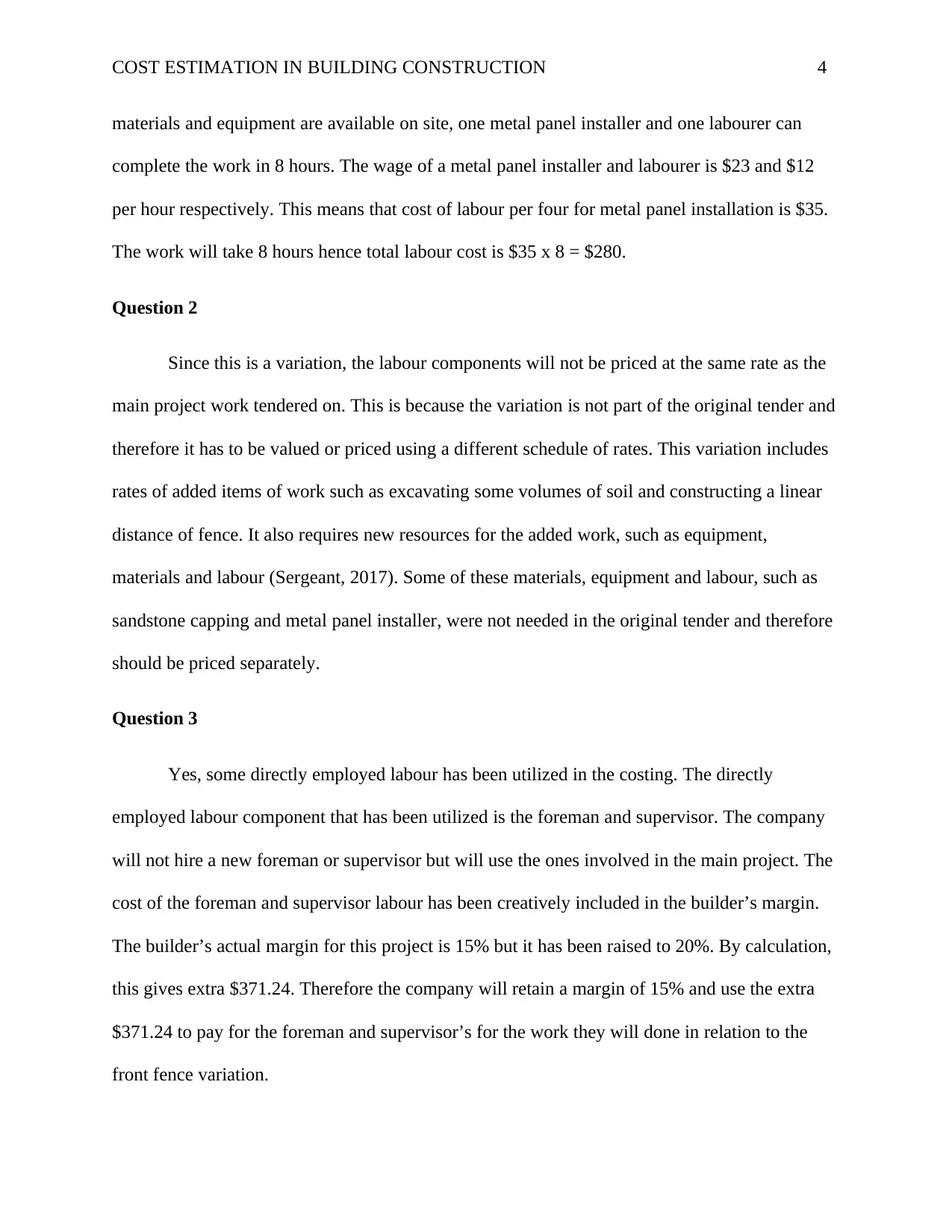
COST ESTIMATION IN BUILDING CONSTRUCTION 4
materials and equipment are available on site, one metal panel installer and one labourer can
complete the work in 8 hours. The wage of a metal panel installer and labourer is $23 and $12
per hour respectively. This means that cost of labour per four for metal panel installation is $35.
The work will take 8 hours hence total labour cost is $35 x 8 = $280.
Question 2
Since this is a variation, the labour components will not be priced at the same rate as the
main project work tendered on. This is because the variation is not part of the original tender and
therefore it has to be valued or priced using a different schedule of rates. This variation includes
rates of added items of work such as excavating some volumes of soil and constructing a linear
distance of fence. It also requires new resources for the added work, such as equipment,
materials and labour (Sergeant, 2017). Some of these materials, equipment and labour, such as
sandstone capping and metal panel installer, were not needed in the original tender and therefore
should be priced separately.
Question 3
Yes, some directly employed labour has been utilized in the costing. The directly
employed labour component that has been utilized is the foreman and supervisor. The company
will not hire a new foreman or supervisor but will use the ones involved in the main project. The
cost of the foreman and supervisor labour has been creatively included in the builder’s margin.
The builder’s actual margin for this project is 15% but it has been raised to 20%. By calculation,
this gives extra $371.24. Therefore the company will retain a margin of 15% and use the extra
$371.24 to pay for the foreman and supervisor’s for the work they will done in relation to the
front fence variation.
materials and equipment are available on site, one metal panel installer and one labourer can
complete the work in 8 hours. The wage of a metal panel installer and labourer is $23 and $12
per hour respectively. This means that cost of labour per four for metal panel installation is $35.
The work will take 8 hours hence total labour cost is $35 x 8 = $280.
Question 2
Since this is a variation, the labour components will not be priced at the same rate as the
main project work tendered on. This is because the variation is not part of the original tender and
therefore it has to be valued or priced using a different schedule of rates. This variation includes
rates of added items of work such as excavating some volumes of soil and constructing a linear
distance of fence. It also requires new resources for the added work, such as equipment,
materials and labour (Sergeant, 2017). Some of these materials, equipment and labour, such as
sandstone capping and metal panel installer, were not needed in the original tender and therefore
should be priced separately.
Question 3
Yes, some directly employed labour has been utilized in the costing. The directly
employed labour component that has been utilized is the foreman and supervisor. The company
will not hire a new foreman or supervisor but will use the ones involved in the main project. The
cost of the foreman and supervisor labour has been creatively included in the builder’s margin.
The builder’s actual margin for this project is 15% but it has been raised to 20%. By calculation,
this gives extra $371.24. Therefore the company will retain a margin of 15% and use the extra
$371.24 to pay for the foreman and supervisor’s for the work they will done in relation to the
front fence variation.
Secure Best Marks with AI Grader
Need help grading? Try our AI Grader for instant feedback on your assignments.
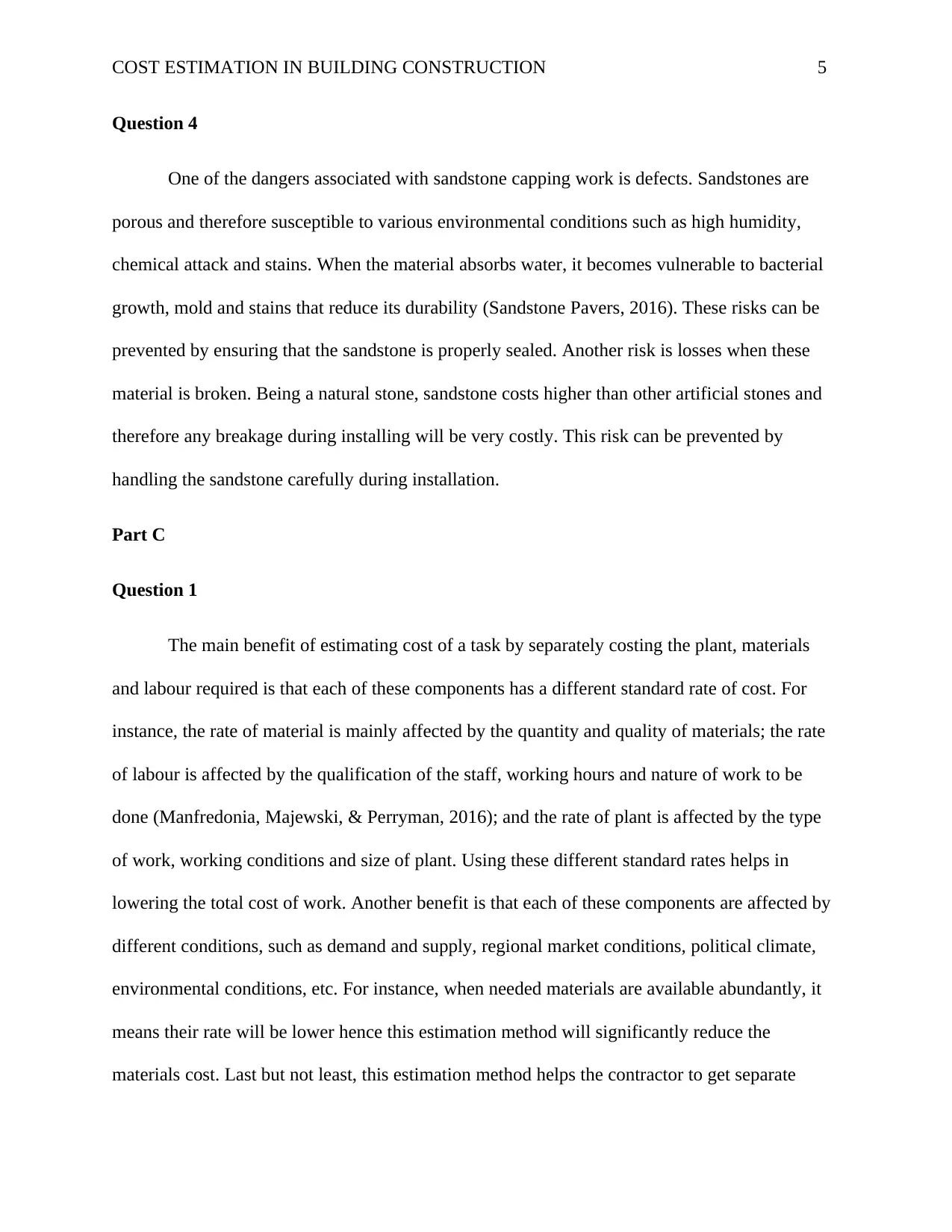
COST ESTIMATION IN BUILDING CONSTRUCTION 5
Question 4
One of the dangers associated with sandstone capping work is defects. Sandstones are
porous and therefore susceptible to various environmental conditions such as high humidity,
chemical attack and stains. When the material absorbs water, it becomes vulnerable to bacterial
growth, mold and stains that reduce its durability (Sandstone Pavers, 2016). These risks can be
prevented by ensuring that the sandstone is properly sealed. Another risk is losses when these
material is broken. Being a natural stone, sandstone costs higher than other artificial stones and
therefore any breakage during installing will be very costly. This risk can be prevented by
handling the sandstone carefully during installation.
Part C
Question 1
The main benefit of estimating cost of a task by separately costing the plant, materials
and labour required is that each of these components has a different standard rate of cost. For
instance, the rate of material is mainly affected by the quantity and quality of materials; the rate
of labour is affected by the qualification of the staff, working hours and nature of work to be
done (Manfredonia, Majewski, & Perryman, 2016); and the rate of plant is affected by the type
of work, working conditions and size of plant. Using these different standard rates helps in
lowering the total cost of work. Another benefit is that each of these components are affected by
different conditions, such as demand and supply, regional market conditions, political climate,
environmental conditions, etc. For instance, when needed materials are available abundantly, it
means their rate will be lower hence this estimation method will significantly reduce the
materials cost. Last but not least, this estimation method helps the contractor to get separate
Question 4
One of the dangers associated with sandstone capping work is defects. Sandstones are
porous and therefore susceptible to various environmental conditions such as high humidity,
chemical attack and stains. When the material absorbs water, it becomes vulnerable to bacterial
growth, mold and stains that reduce its durability (Sandstone Pavers, 2016). These risks can be
prevented by ensuring that the sandstone is properly sealed. Another risk is losses when these
material is broken. Being a natural stone, sandstone costs higher than other artificial stones and
therefore any breakage during installing will be very costly. This risk can be prevented by
handling the sandstone carefully during installation.
Part C
Question 1
The main benefit of estimating cost of a task by separately costing the plant, materials
and labour required is that each of these components has a different standard rate of cost. For
instance, the rate of material is mainly affected by the quantity and quality of materials; the rate
of labour is affected by the qualification of the staff, working hours and nature of work to be
done (Manfredonia, Majewski, & Perryman, 2016); and the rate of plant is affected by the type
of work, working conditions and size of plant. Using these different standard rates helps in
lowering the total cost of work. Another benefit is that each of these components are affected by
different conditions, such as demand and supply, regional market conditions, political climate,
environmental conditions, etc. For instance, when needed materials are available abundantly, it
means their rate will be lower hence this estimation method will significantly reduce the
materials cost. Last but not least, this estimation method helps the contractor to get separate
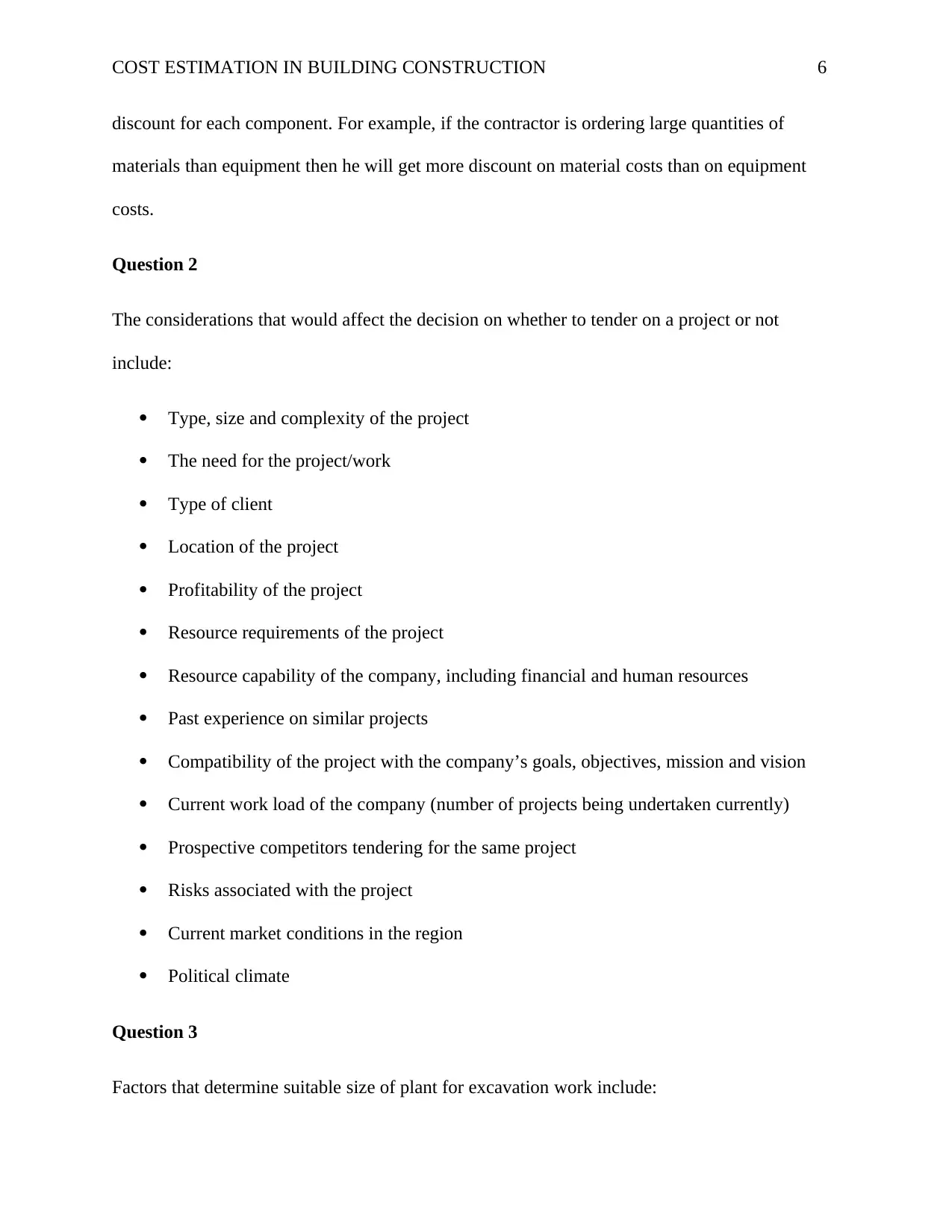
COST ESTIMATION IN BUILDING CONSTRUCTION 6
discount for each component. For example, if the contractor is ordering large quantities of
materials than equipment then he will get more discount on material costs than on equipment
costs.
Question 2
The considerations that would affect the decision on whether to tender on a project or not
include:
Type, size and complexity of the project
The need for the project/work
Type of client
Location of the project
Profitability of the project
Resource requirements of the project
Resource capability of the company, including financial and human resources
Past experience on similar projects
Compatibility of the project with the company’s goals, objectives, mission and vision
Current work load of the company (number of projects being undertaken currently)
Prospective competitors tendering for the same project
Risks associated with the project
Current market conditions in the region
Political climate
Question 3
Factors that determine suitable size of plant for excavation work include:
discount for each component. For example, if the contractor is ordering large quantities of
materials than equipment then he will get more discount on material costs than on equipment
costs.
Question 2
The considerations that would affect the decision on whether to tender on a project or not
include:
Type, size and complexity of the project
The need for the project/work
Type of client
Location of the project
Profitability of the project
Resource requirements of the project
Resource capability of the company, including financial and human resources
Past experience on similar projects
Compatibility of the project with the company’s goals, objectives, mission and vision
Current work load of the company (number of projects being undertaken currently)
Prospective competitors tendering for the same project
Risks associated with the project
Current market conditions in the region
Political climate
Question 3
Factors that determine suitable size of plant for excavation work include:
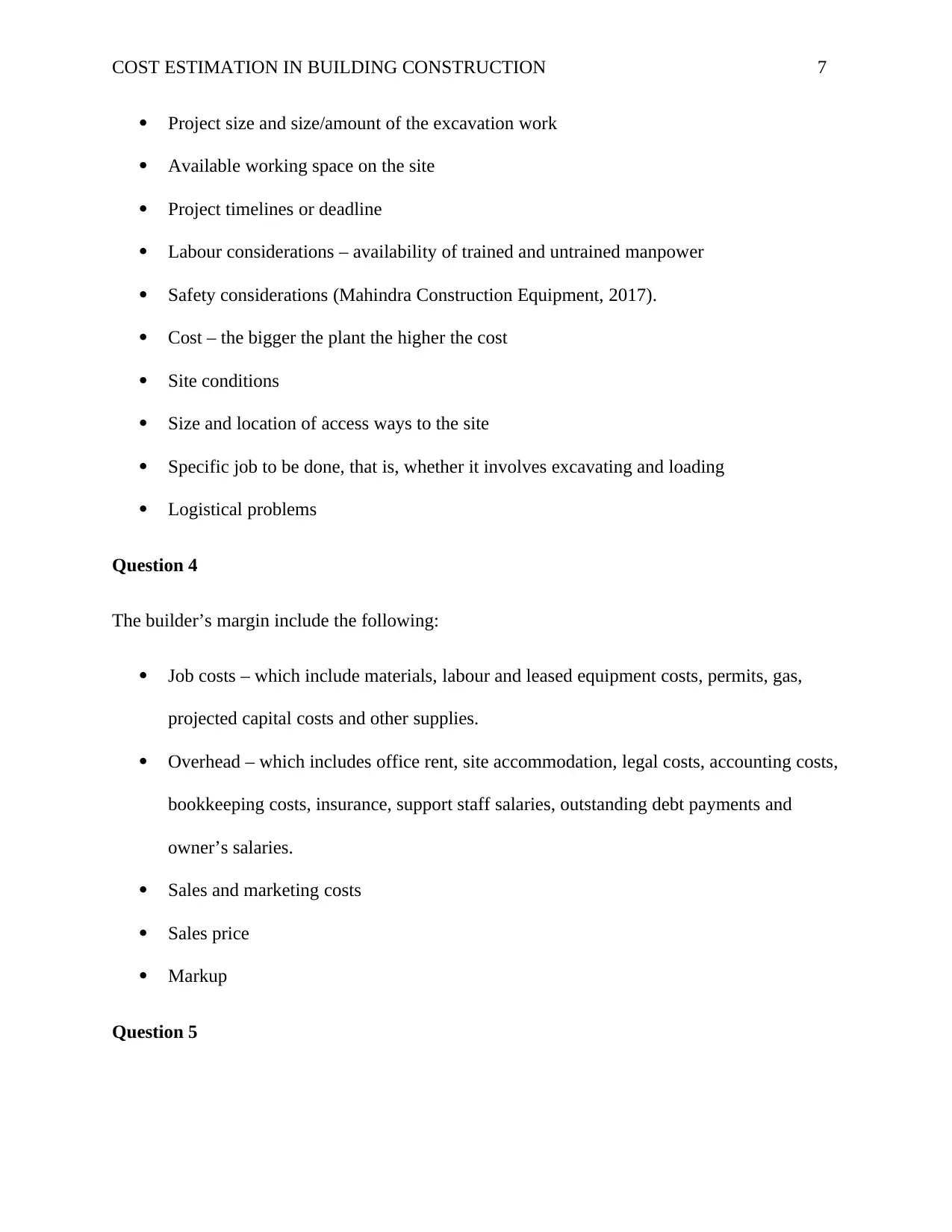
COST ESTIMATION IN BUILDING CONSTRUCTION 7
Project size and size/amount of the excavation work
Available working space on the site
Project timelines or deadline
Labour considerations – availability of trained and untrained manpower
Safety considerations (Mahindra Construction Equipment, 2017).
Cost – the bigger the plant the higher the cost
Site conditions
Size and location of access ways to the site
Specific job to be done, that is, whether it involves excavating and loading
Logistical problems
Question 4
The builder’s margin include the following:
Job costs – which include materials, labour and leased equipment costs, permits, gas,
projected capital costs and other supplies.
Overhead – which includes office rent, site accommodation, legal costs, accounting costs,
bookkeeping costs, insurance, support staff salaries, outstanding debt payments and
owner’s salaries.
Sales and marketing costs
Sales price
Markup
Question 5
Project size and size/amount of the excavation work
Available working space on the site
Project timelines or deadline
Labour considerations – availability of trained and untrained manpower
Safety considerations (Mahindra Construction Equipment, 2017).
Cost – the bigger the plant the higher the cost
Site conditions
Size and location of access ways to the site
Specific job to be done, that is, whether it involves excavating and loading
Logistical problems
Question 4
The builder’s margin include the following:
Job costs – which include materials, labour and leased equipment costs, permits, gas,
projected capital costs and other supplies.
Overhead – which includes office rent, site accommodation, legal costs, accounting costs,
bookkeeping costs, insurance, support staff salaries, outstanding debt payments and
owner’s salaries.
Sales and marketing costs
Sales price
Markup
Question 5
Paraphrase This Document
Need a fresh take? Get an instant paraphrase of this document with our AI Paraphraser
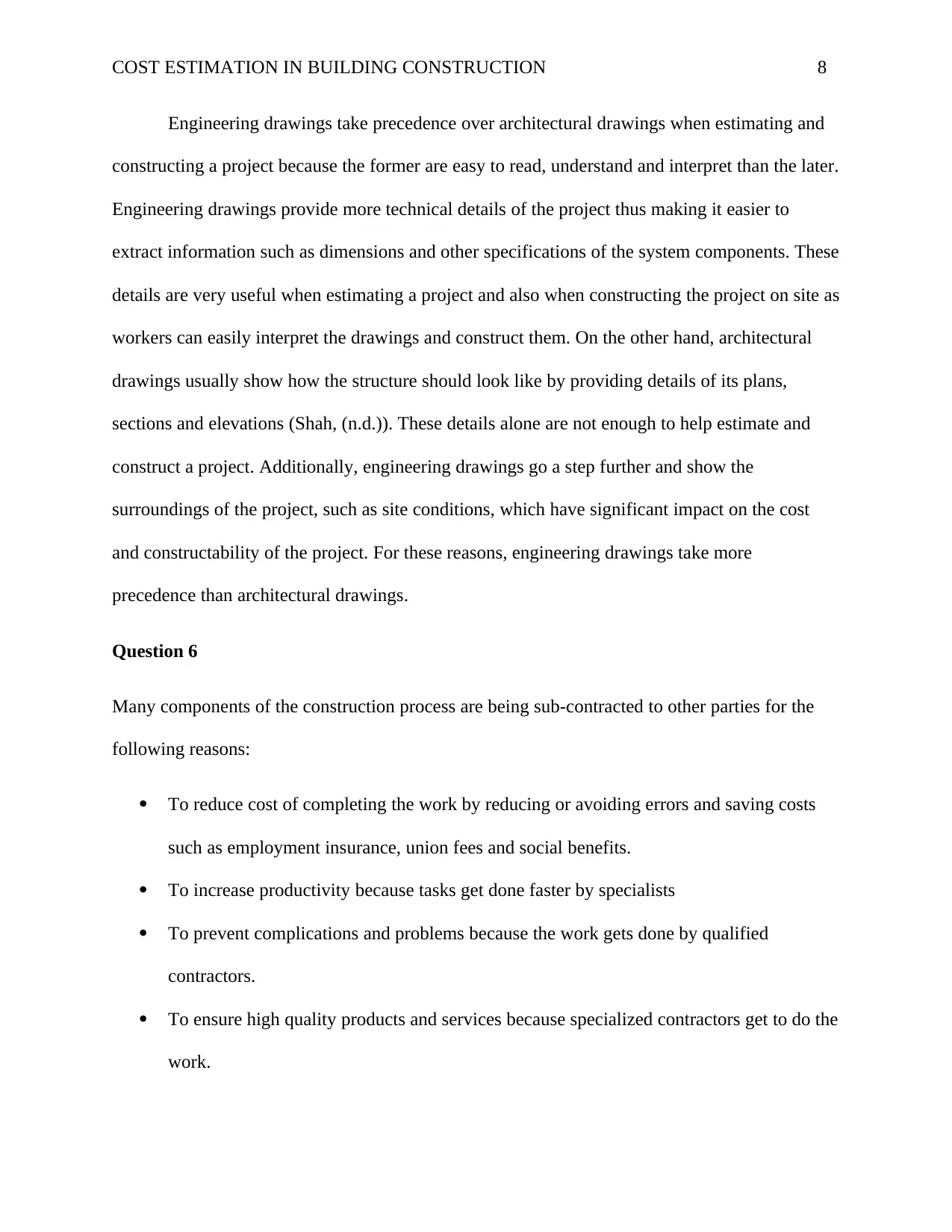
COST ESTIMATION IN BUILDING CONSTRUCTION 8
Engineering drawings take precedence over architectural drawings when estimating and
constructing a project because the former are easy to read, understand and interpret than the later.
Engineering drawings provide more technical details of the project thus making it easier to
extract information such as dimensions and other specifications of the system components. These
details are very useful when estimating a project and also when constructing the project on site as
workers can easily interpret the drawings and construct them. On the other hand, architectural
drawings usually show how the structure should look like by providing details of its plans,
sections and elevations (Shah, (n.d.)). These details alone are not enough to help estimate and
construct a project. Additionally, engineering drawings go a step further and show the
surroundings of the project, such as site conditions, which have significant impact on the cost
and constructability of the project. For these reasons, engineering drawings take more
precedence than architectural drawings.
Question 6
Many components of the construction process are being sub-contracted to other parties for the
following reasons:
To reduce cost of completing the work by reducing or avoiding errors and saving costs
such as employment insurance, union fees and social benefits.
To increase productivity because tasks get done faster by specialists
To prevent complications and problems because the work gets done by qualified
contractors.
To ensure high quality products and services because specialized contractors get to do the
work.
Engineering drawings take precedence over architectural drawings when estimating and
constructing a project because the former are easy to read, understand and interpret than the later.
Engineering drawings provide more technical details of the project thus making it easier to
extract information such as dimensions and other specifications of the system components. These
details are very useful when estimating a project and also when constructing the project on site as
workers can easily interpret the drawings and construct them. On the other hand, architectural
drawings usually show how the structure should look like by providing details of its plans,
sections and elevations (Shah, (n.d.)). These details alone are not enough to help estimate and
construct a project. Additionally, engineering drawings go a step further and show the
surroundings of the project, such as site conditions, which have significant impact on the cost
and constructability of the project. For these reasons, engineering drawings take more
precedence than architectural drawings.
Question 6
Many components of the construction process are being sub-contracted to other parties for the
following reasons:
To reduce cost of completing the work by reducing or avoiding errors and saving costs
such as employment insurance, union fees and social benefits.
To increase productivity because tasks get done faster by specialists
To prevent complications and problems because the work gets done by qualified
contractors.
To ensure high quality products and services because specialized contractors get to do the
work.
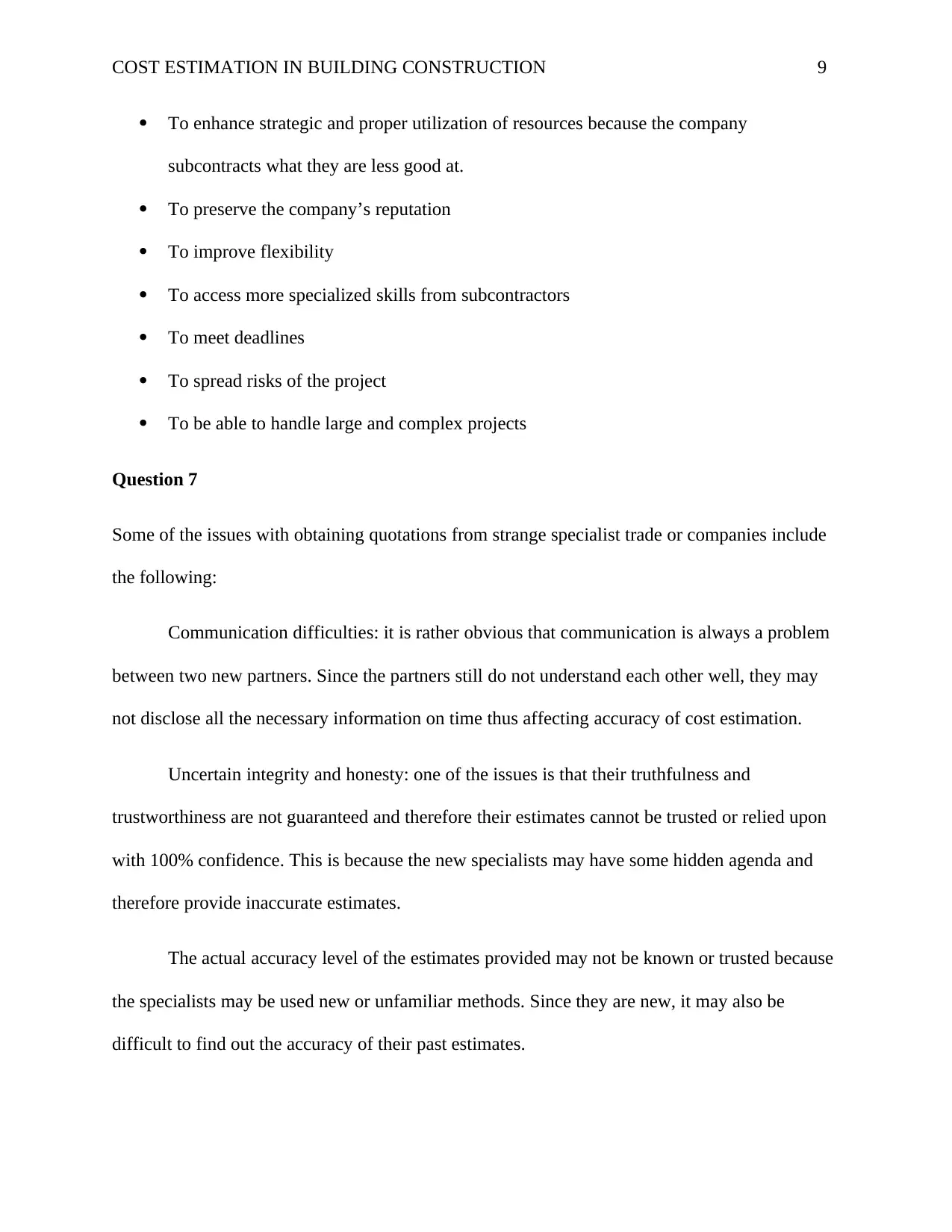
COST ESTIMATION IN BUILDING CONSTRUCTION 9
To enhance strategic and proper utilization of resources because the company
subcontracts what they are less good at.
To preserve the company’s reputation
To improve flexibility
To access more specialized skills from subcontractors
To meet deadlines
To spread risks of the project
To be able to handle large and complex projects
Question 7
Some of the issues with obtaining quotations from strange specialist trade or companies include
the following:
Communication difficulties: it is rather obvious that communication is always a problem
between two new partners. Since the partners still do not understand each other well, they may
not disclose all the necessary information on time thus affecting accuracy of cost estimation.
Uncertain integrity and honesty: one of the issues is that their truthfulness and
trustworthiness are not guaranteed and therefore their estimates cannot be trusted or relied upon
with 100% confidence. This is because the new specialists may have some hidden agenda and
therefore provide inaccurate estimates.
The actual accuracy level of the estimates provided may not be known or trusted because
the specialists may be used new or unfamiliar methods. Since they are new, it may also be
difficult to find out the accuracy of their past estimates.
To enhance strategic and proper utilization of resources because the company
subcontracts what they are less good at.
To preserve the company’s reputation
To improve flexibility
To access more specialized skills from subcontractors
To meet deadlines
To spread risks of the project
To be able to handle large and complex projects
Question 7
Some of the issues with obtaining quotations from strange specialist trade or companies include
the following:
Communication difficulties: it is rather obvious that communication is always a problem
between two new partners. Since the partners still do not understand each other well, they may
not disclose all the necessary information on time thus affecting accuracy of cost estimation.
Uncertain integrity and honesty: one of the issues is that their truthfulness and
trustworthiness are not guaranteed and therefore their estimates cannot be trusted or relied upon
with 100% confidence. This is because the new specialists may have some hidden agenda and
therefore provide inaccurate estimates.
The actual accuracy level of the estimates provided may not be known or trusted because
the specialists may be used new or unfamiliar methods. Since they are new, it may also be
difficult to find out the accuracy of their past estimates.
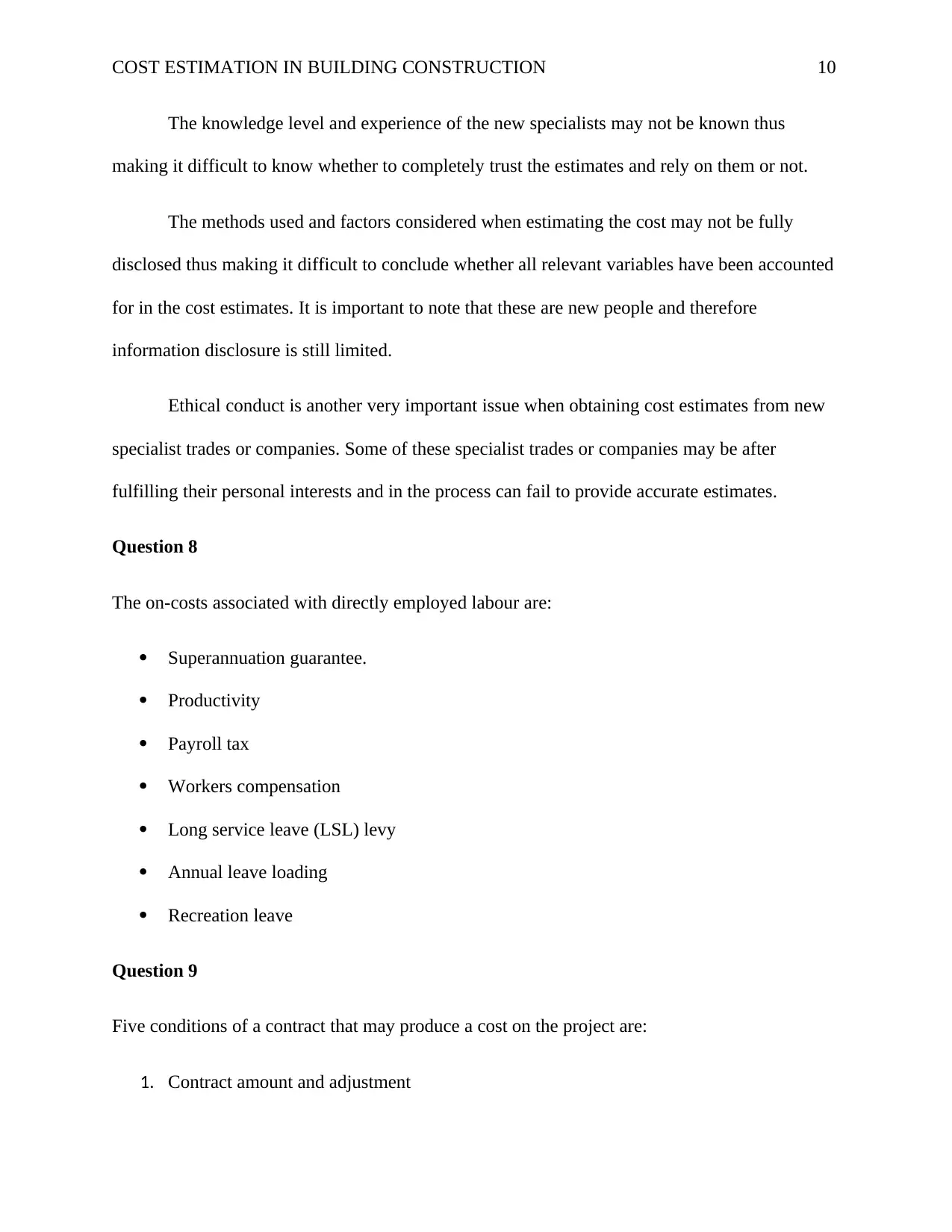
COST ESTIMATION IN BUILDING CONSTRUCTION 10
The knowledge level and experience of the new specialists may not be known thus
making it difficult to know whether to completely trust the estimates and rely on them or not.
The methods used and factors considered when estimating the cost may not be fully
disclosed thus making it difficult to conclude whether all relevant variables have been accounted
for in the cost estimates. It is important to note that these are new people and therefore
information disclosure is still limited.
Ethical conduct is another very important issue when obtaining cost estimates from new
specialist trades or companies. Some of these specialist trades or companies may be after
fulfilling their personal interests and in the process can fail to provide accurate estimates.
Question 8
The on-costs associated with directly employed labour are:
Superannuation guarantee.
Productivity
Payroll tax
Workers compensation
Long service leave (LSL) levy
Annual leave loading
Recreation leave
Question 9
Five conditions of a contract that may produce a cost on the project are:
1. Contract amount and adjustment
The knowledge level and experience of the new specialists may not be known thus
making it difficult to know whether to completely trust the estimates and rely on them or not.
The methods used and factors considered when estimating the cost may not be fully
disclosed thus making it difficult to conclude whether all relevant variables have been accounted
for in the cost estimates. It is important to note that these are new people and therefore
information disclosure is still limited.
Ethical conduct is another very important issue when obtaining cost estimates from new
specialist trades or companies. Some of these specialist trades or companies may be after
fulfilling their personal interests and in the process can fail to provide accurate estimates.
Question 8
The on-costs associated with directly employed labour are:
Superannuation guarantee.
Productivity
Payroll tax
Workers compensation
Long service leave (LSL) levy
Annual leave loading
Recreation leave
Question 9
Five conditions of a contract that may produce a cost on the project are:
1. Contract amount and adjustment
Secure Best Marks with AI Grader
Need help grading? Try our AI Grader for instant feedback on your assignments.
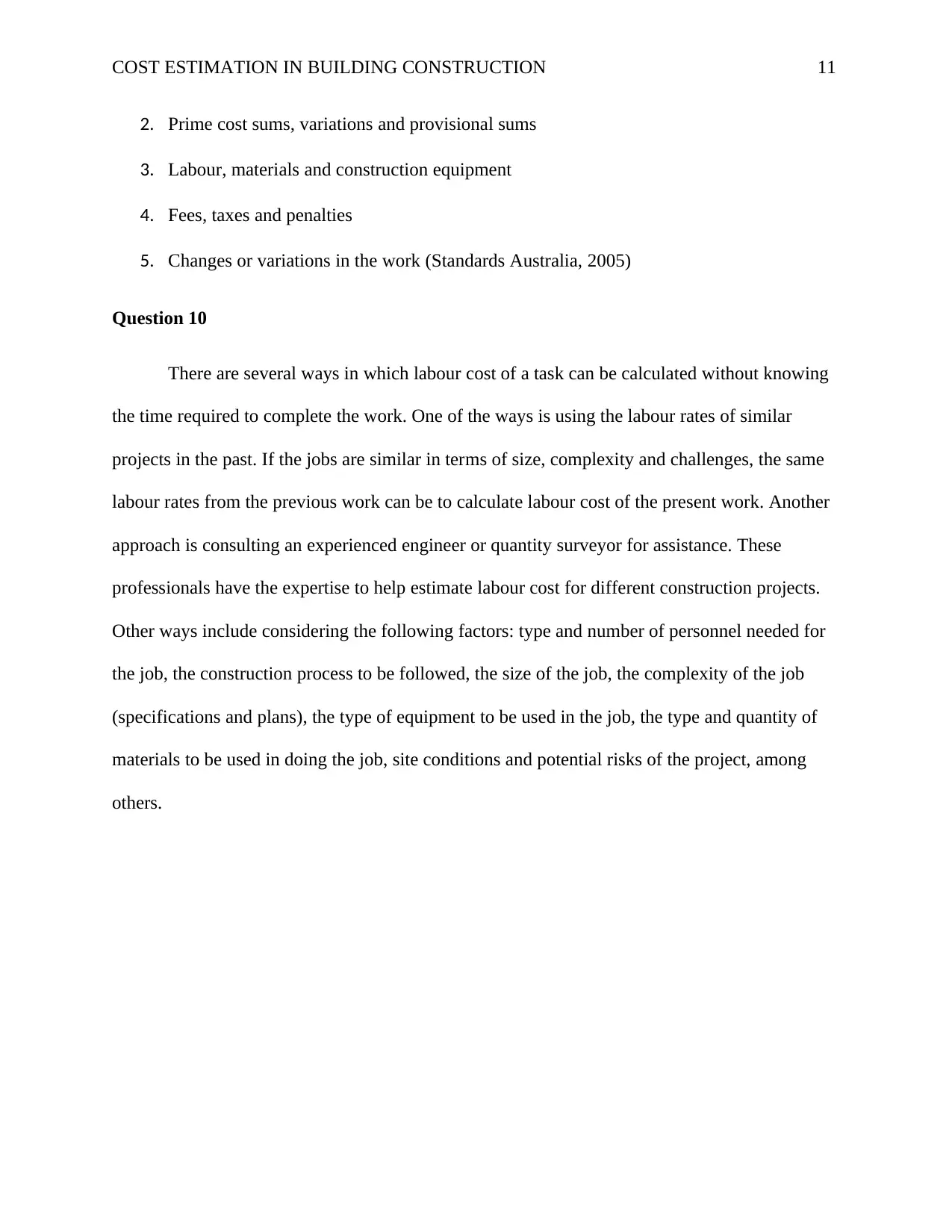
COST ESTIMATION IN BUILDING CONSTRUCTION 11
2. Prime cost sums, variations and provisional sums
3. Labour, materials and construction equipment
4. Fees, taxes and penalties
5. Changes or variations in the work (Standards Australia, 2005)
Question 10
There are several ways in which labour cost of a task can be calculated without knowing
the time required to complete the work. One of the ways is using the labour rates of similar
projects in the past. If the jobs are similar in terms of size, complexity and challenges, the same
labour rates from the previous work can be to calculate labour cost of the present work. Another
approach is consulting an experienced engineer or quantity surveyor for assistance. These
professionals have the expertise to help estimate labour cost for different construction projects.
Other ways include considering the following factors: type and number of personnel needed for
the job, the construction process to be followed, the size of the job, the complexity of the job
(specifications and plans), the type of equipment to be used in the job, the type and quantity of
materials to be used in doing the job, site conditions and potential risks of the project, among
others.
2. Prime cost sums, variations and provisional sums
3. Labour, materials and construction equipment
4. Fees, taxes and penalties
5. Changes or variations in the work (Standards Australia, 2005)
Question 10
There are several ways in which labour cost of a task can be calculated without knowing
the time required to complete the work. One of the ways is using the labour rates of similar
projects in the past. If the jobs are similar in terms of size, complexity and challenges, the same
labour rates from the previous work can be to calculate labour cost of the present work. Another
approach is consulting an experienced engineer or quantity surveyor for assistance. These
professionals have the expertise to help estimate labour cost for different construction projects.
Other ways include considering the following factors: type and number of personnel needed for
the job, the construction process to be followed, the size of the job, the complexity of the job
(specifications and plans), the type of equipment to be used in the job, the type and quantity of
materials to be used in doing the job, site conditions and potential risks of the project, among
others.
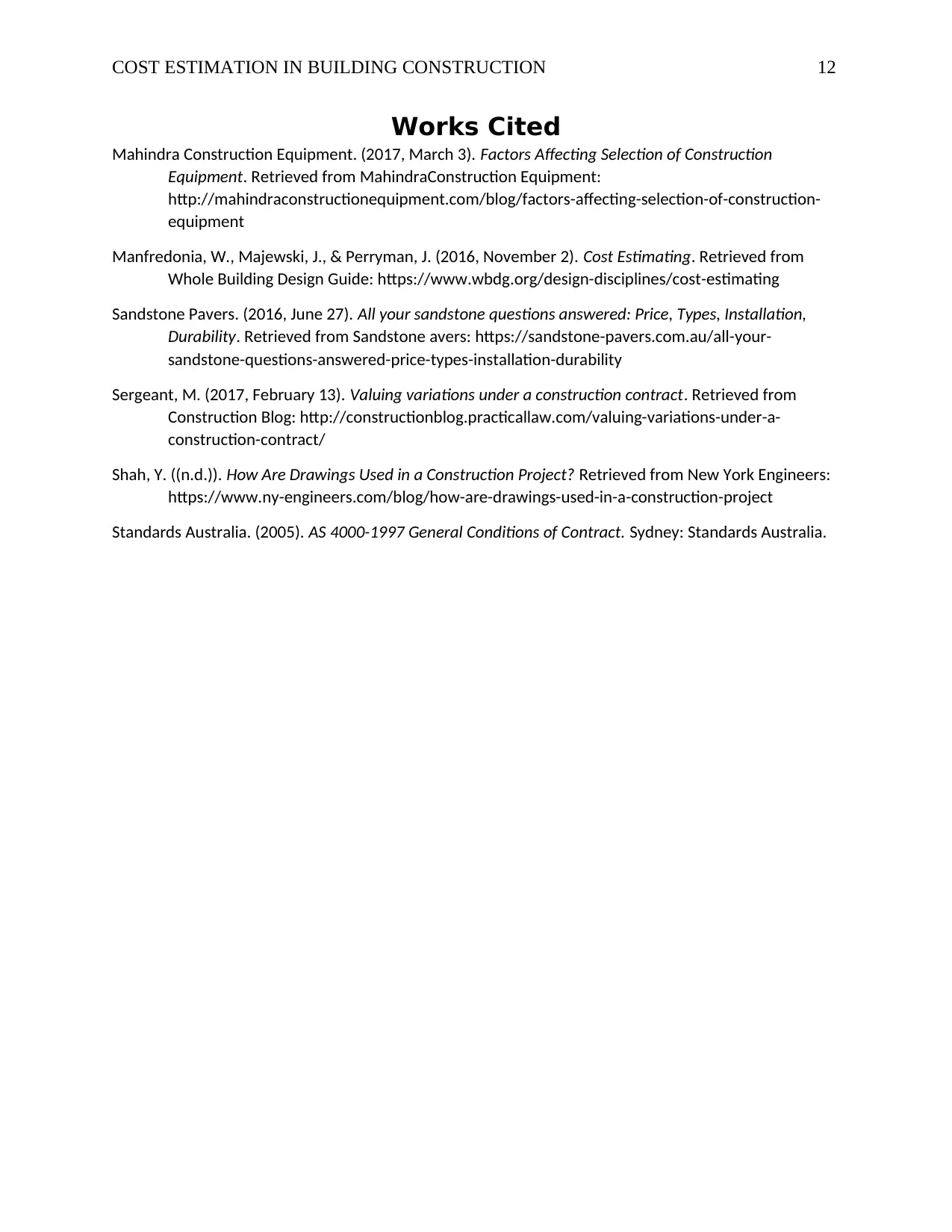
COST ESTIMATION IN BUILDING CONSTRUCTION 12
Works Cited
Mahindra Construction Equipment. (2017, March 3). Factors Affecting Selection of Construction
Equipment. Retrieved from MahindraConstruction Equipment:
http://mahindraconstructionequipment.com/blog/factors-affecting-selection-of-construction-
equipment
Manfredonia, W., Majewski, J., & Perryman, J. (2016, November 2). Cost Estimating. Retrieved from
Whole Building Design Guide: https://www.wbdg.org/design-disciplines/cost-estimating
Sandstone Pavers. (2016, June 27). All your sandstone questions answered: Price, Types, Installation,
Durability. Retrieved from Sandstone avers: https://sandstone-pavers.com.au/all-your-
sandstone-questions-answered-price-types-installation-durability
Sergeant, M. (2017, February 13). Valuing variations under a construction contract. Retrieved from
Construction Blog: http://constructionblog.practicallaw.com/valuing-variations-under-a-
construction-contract/
Shah, Y. ((n.d.)). How Are Drawings Used in a Construction Project? Retrieved from New York Engineers:
https://www.ny-engineers.com/blog/how-are-drawings-used-in-a-construction-project
Standards Australia. (2005). AS 4000-1997 General Conditions of Contract. Sydney: Standards Australia.
Works Cited
Mahindra Construction Equipment. (2017, March 3). Factors Affecting Selection of Construction
Equipment. Retrieved from MahindraConstruction Equipment:
http://mahindraconstructionequipment.com/blog/factors-affecting-selection-of-construction-
equipment
Manfredonia, W., Majewski, J., & Perryman, J. (2016, November 2). Cost Estimating. Retrieved from
Whole Building Design Guide: https://www.wbdg.org/design-disciplines/cost-estimating
Sandstone Pavers. (2016, June 27). All your sandstone questions answered: Price, Types, Installation,
Durability. Retrieved from Sandstone avers: https://sandstone-pavers.com.au/all-your-
sandstone-questions-answered-price-types-installation-durability
Sergeant, M. (2017, February 13). Valuing variations under a construction contract. Retrieved from
Construction Blog: http://constructionblog.practicallaw.com/valuing-variations-under-a-
construction-contract/
Shah, Y. ((n.d.)). How Are Drawings Used in a Construction Project? Retrieved from New York Engineers:
https://www.ny-engineers.com/blog/how-are-drawings-used-in-a-construction-project
Standards Australia. (2005). AS 4000-1997 General Conditions of Contract. Sydney: Standards Australia.
1 out of 12
Related Documents
Your All-in-One AI-Powered Toolkit for Academic Success.
+13062052269
info@desklib.com
Available 24*7 on WhatsApp / Email
![[object Object]](/_next/static/media/star-bottom.7253800d.svg)
Unlock your academic potential
© 2024 | Zucol Services PVT LTD | All rights reserved.




